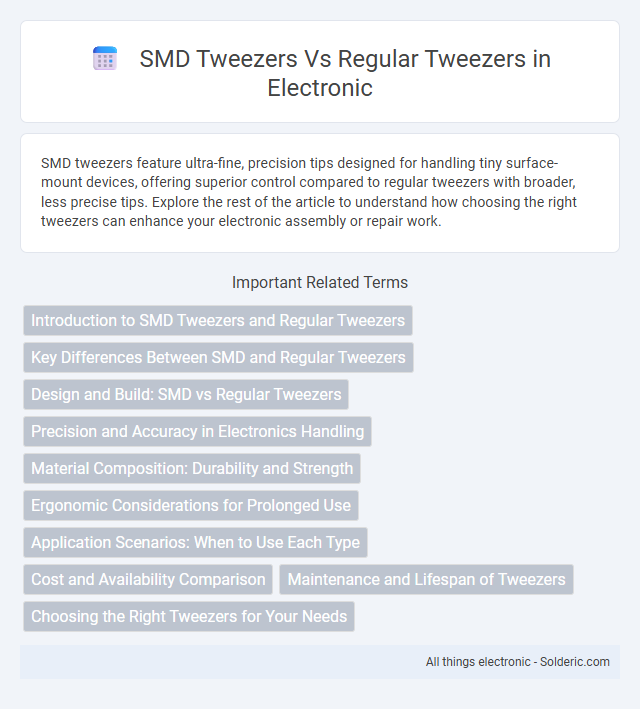SMD tweezers feature ultra-fine, precision tips designed for handling tiny surface-mount devices, offering superior control compared to regular tweezers with broader, less precise tips. Explore the rest of the article to understand how choosing the right tweezers can enhance your electronic assembly or repair work.
Comparison Table
| Feature | SMD Tweezers | Regular Tweezers |
|---|---|---|
| Purpose | Handling small surface-mount devices (SMD) and electronics components | General use for gripping and pulling various objects |
| Tip Design | Fine, precise, anti-static tips for delicate components | Varied tip shapes; less precision |
| Material | Often stainless steel with anti-static coating | Stainless steel or other metals without special coating |
| Size | Smaller, lightweight for precision | Varied sizes, usually larger |
| Use Case | Electronics assembly, repair, and inspection | General household, medical, or cosmetic use |
| Cost | Generally higher due to specialization | Lower, widely available |
Introduction to SMD Tweezers and Regular Tweezers
SMD tweezers are designed with precision tips ideal for handling small surface-mount devices in electronics assembly, offering fine control and anti-static features to protect delicate components. Regular tweezers, commonly used for general purposes, have broader tips and lack the specialized design needed for intricate electronic work. Choosing the right tweezers enhances your accuracy and efficiency during detailed tasks.
Key Differences Between SMD and Regular Tweezers
SMD tweezers feature fine, precise tips designed for handling tiny electronic components, offering superior control and reduced risk of damage compared to regular tweezers. Regular tweezers typically have broader tips suitable for general-purpose use, lacking the precision required for delicate surface-mount device (SMD) tasks. The ergonomic design and anti-magnetic, anti-static materials of SMD tweezers enhance accuracy and safety in electronics assembly, unlike standard tweezers primarily made for everyday tasks.
Design and Build: SMD vs Regular Tweezers
SMD tweezers feature precision-engineered, fine-point tips made from anti-static materials to handle delicate surface-mount devices without causing damage or static discharge. Regular tweezers typically have broader, blunt tips and are constructed from stainless steel or other metals designed for general use, lacking the specialized build to manage tiny electronic components. The ergonomic design of SMD tweezers includes insulated handles and superior tip alignment for enhanced precision and safety during electronic assembly, contrasting with the basic design of regular tweezers.
Precision and Accuracy in Electronics Handling
SMD tweezers offer superior precision and accuracy in electronics handling due to their fine, pointed tips designed for manipulating tiny surface-mount devices on PCBs with minimal damage risk. Regular tweezers lack the specialized tip geometry and often cause slipping or component displacement when handling delicate electronic parts. The enhanced control of SMD tweezers ensures precise component placement and soldering, critical for maintaining circuit integrity.
Material Composition: Durability and Strength
SMD tweezers are typically crafted from high-quality stainless steel or anti-magnetic alloys, ensuring exceptional durability and corrosion resistance in precision electronics work. Regular tweezers often use basic stainless steel or plastic materials, which may lack the strength and longevity required for delicate handling. The superior material composition of SMD tweezers provides enhanced resilience and precision, minimizing wear and deformation during repeated use.
Ergonomic Considerations for Prolonged Use
SMD tweezers are specifically designed with ergonomic features such as lightweight materials, anti-slip grips, and precision tips to reduce hand fatigue during prolonged use in electronics assembly. Regular tweezers often lack these specialized design elements, leading to discomfort and decreased efficiency over extended periods. Ergonomic SMD tweezers minimize strain on fingers and wrists, improving accuracy and user comfort in continuous tasks.
Application Scenarios: When to Use Each Type
SMD tweezers are ideal for precision work in electronics assembly and repair, such as handling tiny surface-mounted devices and components in tight spaces. Regular tweezers are better suited for general-purpose tasks like crafting, household use, or removing splinters, where precision at micro scales is not critical. Choosing between SMD and regular tweezers depends on the need for fine control and the scale of the objects being manipulated.
Cost and Availability Comparison
SMD tweezers typically cost more than regular tweezers due to their precision tips and specialized design for handling small electronic components. Regular tweezers are widely available in general stores and online at lower prices, while SMD tweezers are mainly found in electronic and hobbyist supply shops, which may limit their accessibility. Bulk purchasing options for regular tweezers reduce per-unit cost significantly compared to the niche market pricing of SMD tweezers.
Maintenance and Lifespan of Tweezers
SMD tweezers feature precision tips made from anti-static stainless steel or titanium, enhancing durability and resistance to corrosion compared to regular tweezers. Proper maintenance of SMD tweezers involves careful cleaning with isopropyl alcohol and storage in anti-static cases to prevent tip damage and contamination, significantly extending their lifespan. Your investment in high-quality SMD tweezers ensures more reliable performance over time, especially for delicate electronic components.
Choosing the Right Tweezers for Your Needs
SMD tweezers feature fine, precise tips designed for handling tiny surface-mount devices, making them essential for electronics and delicate assembly work. Regular tweezers are more versatile, suited for general tasks but may lack the precision needed for microelectronics. Choosing the right tweezers depends on the intricacy of your work, ensuring your tools match your project's specific demands for accuracy and ease of use.
SMD tweezers vs regular tweezers Infographic

 solderic.com
solderic.com